 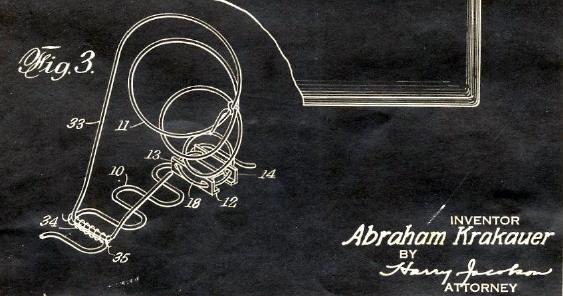 My grandfather, Abraham Krakauer, was awarded 25 United States patents during his lifetime. The image above is part of a figure from one of them, an image of a spring that could be used to stiffen the edge of a cushion or mattress. As president of the family business, Kay Manufacturing Corporation (later Kay Springs), all of his inventions related to springs or furniture, and were assigned to the company. Note 1 But he wasn't the first inventor in his family, and he wasn't the last. During many of my years at Kronos, Incorporated, I had, framed on my office wall, four pages taken from four different patents: one awarded to my great-grandfather Philip Krakauer, Note 2 one awarded to my grandfather Abe, a patent of my father Daniel Krakauer, and finally the first page of a patent of my own. Four generations of inventors, shown in the photo below (taken from my earlier blog entry Abe): 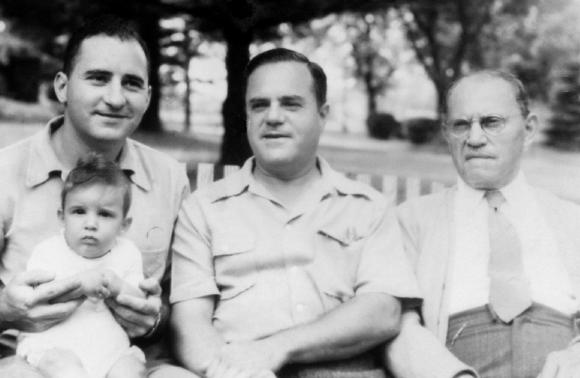 Below are four fragments of the pages I had posted in my office. Click on each image if you want to see the entire page. In most browsers, you can then click on the image to enlarge it. Use your browser's "Back" button to return here.
If you look up Abe's patent 2,156,728 ("Spring structure"), you'll find that the diagrams in the patent itself are drawn with black lines on white paper. But the version I found among Abe's effects is a negative, with white lines on a black background, as shown above (click on it to see the entire page). This was probably made by Abe in 1939 or before, using some blue-print-like copying process available in the drafting department of his company, Kay Manufacturing Corporation. Remember, it wasn't always so easy to make copies of documents - see my earlier blog entry Copies. Note 3 Abe had four sons, in birth order: Daniel David Krakauer (called Dan)
Although Len used "C. Leonard Krakauer", his name seems to be listed as "Leonard C. Krakauer" on his patents. Of the four brothers, three joined the family business (although all four inherited it when Abe died). Bill went to medical school, and became a psychiatrist. In all, I've found 73 patents that can be attributed to Philip, Abe, Dan, Len, Ed, or to me, although the list may be incomplete. The names on these patents are:
Philip (or Phillip): 11
Note: a patent can have more than one inventor, which is why the above numbers add up to more than 73.
I recall being incredibly impressed the first time my father took me in to the factory. I was particularly wowed by rows of MMA ("Metal Mattress Assembly") machines churning out innerspring mattress constructions, and "coilers" producing springs out of rolls of wire. Kay sold the innerspring assemblies to mattress makers, who covered them in padding and fabric to make the final mattress. The "baler" was a very important, if simple, machine. It compressed innerspring assemblies to one-tenth their original thickness, sandwiched between two wooden frames and held in their compressed state by steel straps. If the baler broke, mattress manufacture could only continue for an hour or so. After that, the factory would run out of space, choked by its own output (mattress innerspring assemblies are mostly air). Note that the list only includes patents by Philip and Abe and his descendents (Dan, Ed, Len, and me). But there are also spring or furniture related patents, not on the list, granted to Samuel Krakauer and Wallace Krakauer. Note 4 Samuel was one of Philip's children, hence Abe's brother (the other children were Bella, Fannie, and Pauline). At least one of Samuel Krakauer's patents, 2,282,664, "Apparatus for assembling coiled spring units", was co-invented by Samuel S. Marcus, who was Fannie's husband. Wallace Krakauer was Samuel Krakauer's son, and his patent 2,449,865, "Machine for forming and applying clips to wire members" is assigned to Samuel Krakauer. Note 5 Most of the Krakauer family patents prior to my own relate to the family business. They are mostly patents on springs, spring manufacturing equipment, clips to hold springs in place, spring cushions and mattresses, and other such things. Note 6 But like my uncle Bill, the youngest of Abe's sons, I did not go into the business. Thus, in my capacity as Vice President, Research and Development of Kronos, Incorporated, my patents turned from hardware to software. My favorite was my last patent, co-invented with Larry Baxter. It's number 4,818,969, entitled "Method of fixed-length binary encoding and decoding and apparatus for same". It describes a bar code based on a mathematical curiosity called the "Fibonacci numbers". You can see a description of the invention on my "old" web pages if you click on the next link: The Kronos "Fibonacci Code". If you're interested in using this code, either as a bar code or as a self-clocking code for data communications, let me know. You can use it for free - the patents have now expired. Except the Japanese version wasn't issued until 1996 - maybe it is still valid (although Kronos doesn't use the code any more, and I'll bet they've stopped paying the annual maintenance fees). You can click the next links to see a couple of sample pages of the Japanese version: Page 1 and Page 4. I was sent a copy to check over, so I reviewed it carefully. Yeah, right - I speak essentially no Japanese. If you look at these pages, you might need to click on the images to enlarge them. Then use the "Back" button on your browser to return here. In addition to Japan, patents equivalent to my three US patents were granted in many other countries. Thus although I have only three United States patents, my total patent count is somewhat higher (only the inventor can file for a patent, but he or she then "assigns" it to a company, which pays the filing and maintenance costs, and reaps any benefits). Will my daughters continue the family tradition of filing for patents? Given that they are both educators, it seems unlikely. You can look up patents for free on several web sites, which provide assorted search tools. The site of the United States Patent and Trademark Office can be found at http://www.uspto.gov. There are some other sites that I find easier to navigate. I searched two of them to find patents with an inventor named "Krakauer". Although the results mostly overlapped, there were a few patents found on each of the sites that were not on the other. Thus, since none of the sites I searched was complete, I can't be sure that my list is complete. One of the sites is http://www.freepatentsonline.com/. In addition to a flexible search facility, there's also a quick way to look up a patent on that site if you have its number: type in a URL of the form: where PATNUM is the patent number (without commas). For instance, to look up Samuel Krakauer's patent "2,282,664", go to the URL: Although you may have to scroll down through some ads on the page, it will contain the patent's title and number, the name(s) of the inventor(s), and the publication date, along with other information. Most patents will also include a line that starts with "View Patent Images", followed by a link that allows you to download a complete image of all the pages of the patent, in PDF form. The page whose URL is given just above links to a PDF at: Some of the entries on Free Patents On-line had some problems. For example, in the Wallace Krakauer patent mentioned above, names seem to be reversed - the inventors are listed as "Edgar, Tanguay", "Carl, Kertesz", and "Wallace, Krakauer", when the usual order is "LastName, FirstName". I suspect an error was made in entering patent information for the site. The other site I used was Google, specifically http://www.google.com/patents/. You can also use it to look up a known patent by number, but you need to put a "US" in front of the number for United States patents, and you don't include the "html" at the end. Thus, to see the same patent I looked up just above, you enter the URL: Then click on the thumbnail on the left to get a bigger view.
  Note 1: You can learn more about Abe in my blog entry of that name, which includes photos of his magic Japanese sake cup (hint: click on it). That entry links to a biography that appeared in the August, 1982 issue of "Bedding" magazine, on the occasion of his ninetieth birthday. I also wrote an entry on the subject entitled "Grandpa's first flight", about his first trip in an airplane. And in my entry on Yiddish, you can see a poem Abe wrote in honor of the fortieth anniversary of the Bielsker Bruederlicher Unterstitzungs Verein. [return to text] Note 2: My great-grandfather seemed to spell his name inconsistently, with either one L or two. In the same year, 1928, he spelled it "Philip" in the BBUV program, and a patent was granted with the name spelled "Phillip", as it was spelled in the page from the patent of his that I had hung on my office wall. My cousin Steve Krakauer wrote about Philip's name, "I've seen it both ways. On his citizenship papers, the clerk filled in his name as 'Philip'. However, in the three places he signed it, he spelled it with two L's. He also spelled 'Krakauer' as 'Krakouer', though the clerk wrote it as 'Krakauer'. In the one family tree sketch that Grandpa [Abe] drew, he also spelled it with 2 L's." [return to text] Note 3: The classic work of science fiction A Canticle for Leibowitz, by Walter M. Miller, Jr., begins in the future, 600 years after a nuclear apocalypse has destroyed civilization. In it, a monk of the fictional "Albertian Order of Leibowitz" carefully copies a document, considered to be sacred by the order, which is actually a blueprint similar Abe's, with white lines on a black background. He meticulously inks his copy in dark ink, leaving the paper white to create the lines (actually, watercolor artists have to work this way, since in watercolor, you can't paint in white). Ultimately, after an arduous and dangerous trip to Rome, he discovers in a Rome library that the white lines on a dark background have no particular significance, but rather are just an accidental result of the copying process. [return to text] Note 4: Samuel Krakauer's patents were 1,406,051 [2/7/1922]; 1,502,510; 1,906,159; 2,056,727; 2,166,636; and 2,282,664. I can only find a single patent by Wallace Krakauer, 2,449,865 [9/21/1948]. Samuel's children were Wallace, Irvin, and Florence. [return to text] Note 5: My cousin Steve wrote, "As the story was told to me, Sam Krakauer and Sam Marcus [who had married Philip's daughter Fannie] left Kay to start a competing business. As a result of this disloyalty, [Philip] disowned Sam. However, he did not disown Fanny for standing by her husband." I'm indebted to Steve for much of my detailed information about Krakauer family relationships. [return to text] Note 6:
Ed did have a few patents unrelated to the business. 3,630,053 and 3,680,337, both entitled "Safety lock", were on a pick-proof lock. As an electrical engineer, I find his patent 2,518,909, Signal responsive to current-passage time to be particularly interesting. Ed realized that devices that burn out after a time (like a lamp filament, for instance) can be used as indicators of long time periods having elapsed. Consider wiring an incandescent bulb so that it is powered whenever a machine is on. When it burns out (after many months), it indicates that the machine has run for sufficient hours to need preventive maintenance. That's the general idea; the "burnout" time can be better controlled by subjecting an element to electrolytic corrosion, or other such means. [return to text]
 |

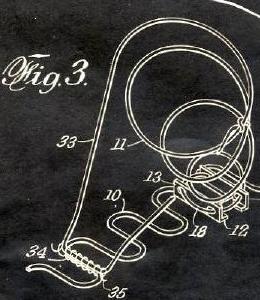
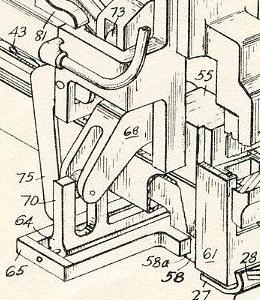

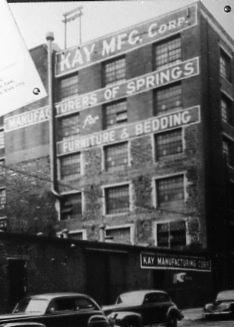 In the years in which my father Dan was President of Kay, Ed, a mechanical engineer, was Vice President of Engineering. That probably accounts for his larger number of patents. Len was Vice President of Manufacturing.
In the years in which my father Dan was President of Kay, Ed, a mechanical engineer, was Vice President of Engineering. That probably accounts for his larger number of patents. Len was Vice President of Manufacturing.